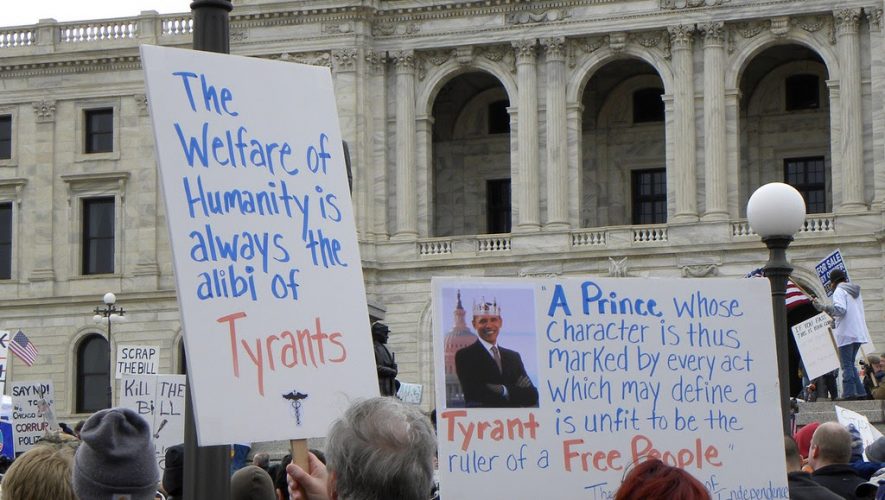In light of the COVID-19 pandemic, Americans have once again found themselves comparing their national health-care policies to those of countries with universal health care. The allure of single-payer health care is clear—particularly as costs continue to rise and we enter a global recession.
As productive as it may seem, universal health care is not the solution to our crisis. Such government interference will undermine efficiency and result in Americans having less care overall.
The History of Universal Health Care in America
The push for universal health care in the US began during the early twentieth century, when reformers proposed compulsory insurance to protect laborers. President Franklin Delano Roosevelt attempted to pass universal health-care legislation twice, believing that the Great Depression had created ideal conditions for it because of mass unemployment that limited access to insurance. The policy was first featured in the Social Security Bill of 1935 but was ultimately excluded when FDR’s Committee on Economic Security expressed concern that the section would sink the bill. The second attempt was the 1939 Wagner Bill, which aimed to fund a national health-care program through federal grants to states. However, the plan was thwarted by a conservative resurgence.
Under President Truman, the Wagner-Murray-Dingell Bill proposed a national medical insurance program funded by social security payroll taxes but failed due to mass opposition from the American Medical Association and the American Hospital Association. After the 1950 midterms, most Democrats stopped pursuing comprehensive public health insurance.
While all-encompassing government-run insurance never materialized, former President Lyndon B. Johnson signed Medicare and Medicaid into law, providing insurance to those older than sixty-five or with disabilities and those with low incomes, respectively. These programs greatly expanded access, but they—along with inflation, increased hospital expenses, and use of more expensive treatments—also contributed to increased consumer costs.
By the 1990s, health-care costs were increasing at twice the rate of inflation. In an attempt to offset these spiraling costs, the Obama Administration pioneered the Affordable Care Act (ACA)—based on the 2006 reform led by Republican Massachusetts Governor Mitt Romney—which sought to provide all citizens with health care by subsidizing consumers with tax credits.
Today Medicaid is a federal–state partnership that covers non-elderly adults with an income of up to 138 percent of the federal poverty level. In 2017, Medicare covered seventy-five million low-income Americans––12.6 million of whom became newly eligible under the ACA expansion.
In contrast, Medicare is a federal program that covers people with disabilities, dialysis patients, and those older than sixty-five regardless of their income. Original Medicare includes hospital and medical insurance, but Medicare Advantage—which is operated by private insurers—sometimes includes prescription drug coverage. Despite numerous reforms, the trend of rising costs has continued through 2020.
Medicare’s Allure
Democrats have criticized the ACA for giving too much power to private insurers and not providing enough support to those who cannot afford insurance. Much of the health-care debate in this year’s presidential primary focused on expanding state-sponsored coverage.
Universal health-care advocates argue that a single-payer system would operate more efficiently than a private one. Not only would a program like Medicare for All simplify things, it would also correctly treat health care as a public good rather than a normal good. Policies like Medicare for All treat health care as a human right and distribute it based on medical need rather than societal factors such as the ability to pay.
The solution proposed by democratic socialists like Senator Bernie Sanders or progressives like Senator Elizabeth Warren is some variation of Medicare for All. While these policies vary in nuance, they would result in single-payer government-run insurance. Effective, affordable, universal coverage is certainly ideal, but it is not as efficient as advocates claim.
Less Coverage, Ballooning Costs
During his campaign, Sanders frequently cited a 2020 Yale study that concluded Medicare for All would save $450 billion in costs and prevent sixty-eight thousand unnecessary deaths annually. However, researchers applied the existing Medicare fee structure to the entire population of theoretically covered individuals. This rendered the study inherently flawed, as the Medicare fee structure systemically undervalues health-care costs.
The Center for American Progress, a liberal think tank, estimates that private payers compensate hospitals between 189 and 241 percent more than Medicare rates. While there is evidence that hospitals overcharge the average consumer, this is often a consequence of cost-shifting to make up for low government reimbursement rates. A study published in the National Bureau of Economic Research found that hospitals experiencing reimbursement cuts from value-based Medicare programs negotiated higher average payments from private payers.
Medicare has lower rates for the entire health-care system, indicating that its fee structure would not maintain the same level of coverage that private insurance currently does. According to Cato Institute health-care expert Tom Miller, the federal government “dictates below-market reimbursements with its near-monopoly power as a purchaser of health care for seniors. The full costs of such price discounts eventually reduce access to quality care and hold health care markets hostage to political exploitation.”
Not only would Medicare for All cost more than Sanders’ conservative estimate, but history indicates that any single-payer initiative would be significantly more expensive than projected and result in higher taxes and rationing. When traditional Medicare was debated in 1965, the federal government estimated that Part A—which covers hospital care—would cost $9 billion by 1990; the program totaled more than $66 billion in that year alone. A 1968 Tax Foundation study discovered that just three years after Medicare’s passage, public spending on Medicare doubled.
Recent iterations of single-payer healthcare have produced similar results. California’s 2017 Universal Healthcare Bill was passed by the state Senate but ultimately failed because the policy was estimated to cost a minimum of $400 billion annually and would double the state budget. Vermont’s single-payer experiment also failed due to high cost.
Universal Health Care’s Secret Price
Cost is certainly a concern, but the true price of universal health care is innovation. While the US ranks fifteenth in health care and trails several single-payer nations, it has produced the most medical and biotechnology patents and is a leader in pharmaceutical development.
Innovation is fueled by the free market, and the medical industry is no exception. The US has more clinical trials and Nobel Awardees in Physiology and Medicine than any other country. American medical innovation is made possible by university research and private investment in research and development. It is no coincidence that this corresponds with the absence of universal, government-run health care.
The global medical economy benefits from the research and development that is fueled by the American free market, which allows other countries to regulate industries like pharmaceuticals. A substantial part of the discrepancy between international and American prescription pricing is due to the greater use of newer and stronger medications in the US. A smaller portion of this discrepancy is due to Americans bearing the burden of research and development for the rest of the world.
If there was less money in health care, the market would shrink and innovation would drop. In the medical industry, this translates to lost lives. From 1960 to 2000, life expectancy grew by seven years at a cost of only about $20,000 per year of life gained because of innovation for treating premature infants and those with cardiovascular disease. While Americans front the cost of health-care innovation, this results in better long-term care that would not be possible under universal health care.
Solutions
Artificially stimulating demand for health care is not the solution to our problem. Everyone wants health care, but it does not become more affordable if the government decides to artificially manipulate the cost of insurance for consumers.
We have a supply-side problem, not a demand problem. As a country, we need to focus less on government intervention and more on incentivizing insurance companies to provide better value. The free market is equally guilty of mispricing goods and services as the government, but the difference is that while the free market adjusts prices to the marginal cost, government price errors do not self-correct.
To incentivize insurance companies to provide better care, we need to strengthen the free market by eliminating barriers to competition and catalyzing innovation. Reforms should ensure that providers improving value are sufficiently rewarded with market share. Because health-care policy has resulted in consumers being insulated from costs and thus unaware of bargain hunting, lowering costs would not result in an influx of customers for insurance companies. Increased transparency is essential for lower prices. A prime example of this is President Trump’s price-transparency rule that requires hospitals to disclose confidential rates they negotiate with insurance companies; this will help patients understand their out-of-pocket expenses.
The US health-care system also requires reforms to promote competition. Decision-makers must have choices at every level, whether they be consumers picking insurance or clinicians deciding where they receive care. The availability of choices pressures the market to improve. Choice exists now, but increased transparency is essential for consumers to make informed decisions.
Americans require a system that incentivizes private companies to provide more care. Everyone should have access to care, particularly the most vulnerable among us. But programs like Medicare for All will not actually yield a superior system. The gravitas of health-care reform is evident, but after thirty years of implementing policy through the federal government, it is time to return to the free market.



